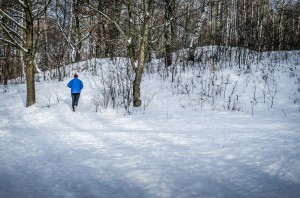 You have no doubt noticed that it seems to take longer to get up to speed when you exercise in cold weather, and there’s a very good reason for that.
You have no doubt noticed that it seems to take longer to get up to speed when you exercise in cold weather, and there’s a very good reason for that.
Our muscles are strongly affected by temperature and the colder it is, the harder it is for them to function efficiently. You may experience this as stiffness, but if you don’t take proper care you may also experience this as an injury…
Why is temperature so important?
We’re always being advised to to warm up before starting any type of hard exercise — whatever the weather — but of course many of us don’t!
In the summer we can get away with it much more readily, but we really need to be more vigilant come winter, and here’s why.
When our muscles are cold, our blood vessels narrow — a process called vasoconstriction — and they can’t work as well. But as soon as you start even a very gentle warm-up, the blood flow increases, the arteries widen (this is called vasodilation), more oxygen reaches your muscles, and they start to work more effectively.
And that means you’re much less likely to pick up an injury than if you go flat out straight into your workout.
What’s the best way to warm up?
Gently stretching the muscle groups you’re about to use in your workout is ideal, even though most of us tell ourselves we don’t have the time to stretch after our session, let alone before!
If that’s you, then why not try just incorporating a less intense or strenuous version of the exercise you’re set to do?
So if you’re about to go for run, just walk steadily for five minutes first. And if you’re getting on your bike, start the session by cycling very gently around the block before cranking up the speed and intensity.
Is it OK to wear shorts?
Generally speaking, no.
We’ve all seen hardy elite (and not so elite!) runners out there on snowy cross-country routes in mid-winter just wearing their shorts, singlets and spikes, but the fact is that their muscles won’t be thanking them for it!
One muscle in particular is highly susceptible to a drop in temperature — the deep calf muscle, or soleus.
Also known as the second heart because of its key role in helping pump blood up from the feet and legs back into the body, the soleus contracts when both lengthened and shortened, making it very efficient at what it’s designed to do.
But only when it’s nice and warm — as soon as the temperature drops, the soleus’ efficiency is affected and if you exercise outside in winter wearing shorts or capri pants you should seriously consider swapping them for leggings or tights. They may feel more cumbersome, but your soleus and your other leg muscles will definitely thank you for it and you’re significantly reducing your chances of getting injured as well as potentially enhancing your performance.
What should I wear on top?
Your top half is less susceptible to the effects of the cold as for most types of exercise your upper body muscles are under a lot less strain than your legs.
You can therefore be a little more relaxed about what you wear, but a top made from an efficient wicking fabric that also has one or more zips to regulate your temperature is ideal. It will absorb sweat while you’re on the move and that in turn will prevent you from getting cold as the body cools down — especially if you’re still outside and can’t get indoors quickly.
Anything else I should do?
If you’re exercising four or more times a week, incorporating a regular therapeutic massage session into your training session makes a lot of sense — particularly in winter when you may also feel less motivated to get out there!
At The Wells Clinic, we work with a lot of amateur and professional athletes to keep them on the move — whatever the weather! You can find out more about our therapeutic services here.
